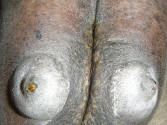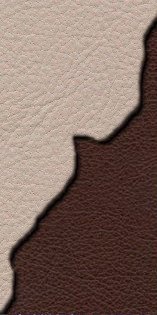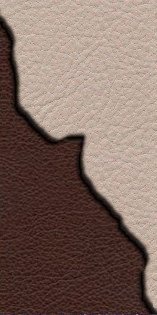

Signs Of Foaling
Under Construction
Coming soon...

True wax, colostrum colored, on the left teat
Breeding on Foal Heat
We rarely breed on foal heat because it is only successful
about 50% of the time. Adding in that this is shipped semen, and not fresh,
might reduce those chances. The mare's uterus will go a long way toward
healing in that first week, but it's just not "all the way there" by the
time she ovulates. Sometimes, mares don't even produce a viable follicle on
foal heat. But what most frustrates me is that we can get mares pregnant on
foal heats, but a larger percentage lose their pregnancies later. We got a
reining-bred mare pregnant on her foal heat last year (ultrasounded in foal
at about 20 days, everything looking good). For some reason, she lost her
foal later on.
Also, if a mare ovulates before the foal is 10 days old, there is a smaller
chance that she will get pregnant and stay pregnant. So, we'll be hoping
that your mare won't be ready to ovulate until Friday or Saturday. That
would mean she is going to have the better chances for success.
From
http://horsedoc_org.tripod.com/id104.htm
We do have criteria to follow when deciding if the mare should be bred on
foal heat:
* If the mare had any difficulty foaling, such as a prolonged labor,
difficult labor requiring help, or received any injuries during the foaling
process, we suggest not breeding on the foal heat. * Also, if the mare
retained the placenta for longer than four hours, we suggest waiting.
* Another criteria we use when deciding to breed the mare is the expense and
trouble involved in getting the mare to the stallion. Breeding on foal heat
will result in a pregnancy in fifty percent of the time. If you are taking
the mare some distance away, or want to breed her with cooled shipped semen,
we suggest passing on the foal heat in favor of the next heat which should
give a considerably higher pregnancy rate.
For the mares we are breeding with shipped semen, we suggest flushing the
uterus before the foal heat, along about seven days. This will evacuate the
uterus and speed its recovery. We then let the mare pass through foal heat.
Once foal heat is over, we culture the uterus to be sure there is no
infection present. Culturing the uterus before foal heat is sure to find
bacteria present as it is almost impossible to have a clean culture at this
time. The process of having a heat is a cleansing time as the blood cells
responsible for consuming bacteria are rushed into the uterus.
From
http://www.ctba.com/01magazine/apr01/images/thomas.pdf
According to Heidi Smith, DVM (a veterinarian at Terrebonne, Oregon who
specializes in equine reproduction) if foaling is clean and the placenta is
shed promptly, the odds are quite good for successful breeding on foal heats
occurring later than 12 days after birth. Mares coming into estrus too soon
after giving birth are not ready to support a new pregnancy; the uterus may
still have fluid in it and the uterine lining may not have returned to its
former condition. Pregnancy rate in these mares may be 20 percent lower than
in mares bred during subsequent heat cycles. Mares that ovulate at least 10
days or later after foaling, with little or no fluid left in the uterus,
have a much better chance of becoming pregnant.
From
http://www.extension.org/pages/Foal_Heat_Mares
Data from different farms have shown foal heat conception rates up to
seventy-five percent. One can skip foal heat and breed on the next heat
cycle allowing the uterus more time to involute or another plausible option
is to short cycle the mare after the foal heat ovulation with
prostaglandins. Some breeding farms will also not breed on foal heat if the
mare ovulates 10 days or less after foaling. In other words they breed on
foal heat as long as ovulation occurs ten days after foaling and the other
criteria are met, normal foaling, etc.
From
http://pedlar.com/index.php?option=com_content&task=view&id=49&Itemid=41
The day ten rule makes sure the uterine environment is ready for an
embryo. Post-foaling, the uterus needs roughly sixteen days before itís nice
enough for the embryo to survive. That means that if youíre going to breed
her on her foal heat, she canít ovulate before day ten. The reason for this
is that after she ovulates, the egg is fertilized and lives in the fallopian
tube for five or six days before it comes into the uterus. If she ovulates
before day ten and youíve bred her, the embryo will come into the uterus
before it has had time to prepare. If youíre going to do something to induce
ovulation, you want to make sure your timing is right so she ovulates on or
after day ten.
This is interesting:
http://www.vetmed.lsu.edu/eiltslotus/Theriogenology-5361/equine%20b.m.e._2.htm
If foal heat ovulation is on day 5-6 postpartum the conception rate is
0%, if it is on day 7-8 postpartum it is about 32%, if it is on days 9-12
postpartum conception rate is about 60%, and if it is grater than 12 days
postpartum conception rates run greater than 75%.
Photo Ownership Notice:
All of the photos on this page are the property of Cedar Ridge QH's or were
sent to us with permission.
If someone has sent a photo to us for use on our pages that belongs to you,
and if they did not have
permission to do so,
please let us know.
If you are interested in contributing a photo, we thank you! But please do not
alter the photo or place your contact
information on it. Our educational pages are for just that...education. Not
advertisements. Thanks!
This page last updated 03/26/10
This page last updated
08/10/20
If you notice this date being 2 years or older, please let
us know that we need to check out this page!


Home Horses For Sale Stallions Mares Foals Blog Color Genetics Riding Horses Site Map Contact Us

Toni Perdew
Bedford, Iowa
toni@grullablue.com
712-370-0851 cell, before 9 p.m. CST
![]()
www.facebook.com/CedarRidgeQuarterHorses
Web design by
CR
Equine Sites.
All rights reserved. Graphics are watermarked for copyright protection.
Terms of Use
